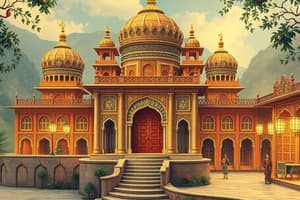Podcast
Questions and Answers
The literacy rate in South Asia was higher than the global average in 2016.
The literacy rate in South Asia was higher than the global average in 2016.
False (B)
What was the GDP per capita of South Asia in 2017?
What was the GDP per capita of South Asia in 2017?
$6,485
Which country in South Asia had the highest life expectancy in 2017?
Which country in South Asia had the highest life expectancy in 2017?
- Bangladesh
- India
- Pakistan
- Sri Lanka (correct)
In 2016, the infant mortality rate in South Asia was _____ per 1,000 live births.
In 2016, the infant mortality rate in South Asia was _____ per 1,000 live births.
Match the following countries with their respective adult literacy rates (2006-2016):
Match the following countries with their respective adult literacy rates (2006-2016):
What was one of the main grievances of the people from East Pakistan during their time as part of Pakistan?
What was one of the main grievances of the people from East Pakistan during their time as part of Pakistan?
The Urdu language was embraced by the Bengali population of East Pakistan.
The Urdu language was embraced by the Bengali population of East Pakistan.
What was the role of the army under General Yahya Khan during the protests in East Pakistan?
What was the role of the army under General Yahya Khan during the protests in East Pakistan?
Democracy in Bangladesh emerged after the region's separation from ________ in 1971.
Democracy in Bangladesh emerged after the region's separation from ________ in 1971.
Match the following events or movements with their significance:
Match the following events or movements with their significance:
Flashcards are hidden until you start studying
Study Notes
South Asia Democracy Insights
- Over 19,000 citizens from five South Asian countries were interviewed to assess support for democracy.
- Historical belief: democracy thrives only in prosperous nations, challenging views with South Asia's democratic evolution.
Socioeconomic Indicators (2017 Data)
- Life Expectancy: South Asia averages 69.3 years; Bangladesh (72.8), India (68.8), Nepal (70.6), Pakistan (66.6), Sri Lanka (75.5).
- Adult Literacy Rate (2006-2016): South Asia at 68.7%; Bangladesh (72.8), India (69.3), Nepal (59.6), Pakistan (57.0).
- Gross Secondary Enrolment Ratio (2012-2017): South Asia averages 71%; Bangladesh (69), India (75), Pakistan (46).
- GDP per Capita (PPP, 2017): South Asia averages 6,485;Bangladesh(6,485; Bangladesh (6,485;Bangladesh(3,524), India (6,427),Pakistan(6,427), Pakistan (6,427),Pakistan(5,035).
- Infant Mortality Rate (2016): South Asia at 37.8 deaths per 1,000 live births; Bangladesh (28.2), India (34.6), Pakistan (64.2).
- Tuberculosis Cases (2016): South Asia averages 206.3 per 100,000 people; Bangladesh (221.0), India (211.0), Pakistan (268.0).
- Population below Poverty Line (2016): Varies by country with significant poverty presence; Sri Lanka notably lower at 76 HDI rank.
Historical Context of Democracy (Since 1947)
- 1947: India and Pakistan gain independence, shaping the region’s political landscape.
- Bangladesh's Emergence: Initially part of Pakistan, Bangladesh fought for representation against dominance from western Pakistan, leading to its independence in 1971.
- Military Dominance: Pakistan's military capitalized on the lack of international support for democratic rule, creating a cycle of military governance.
Indo-Pak Relations
- Ongoing tensions over strategic issues like Siachen Glacier control and an arms race, with both countries developing nuclear capabilities in the late 1990s.
- India's nuclear test in 1998 prompted Pakistan’s immediate nuclear response, establishing a new dynamic in their military relationship.
- Reduced likelihood of full-scale war but persistent mutual suspicion and conflict.
Regional Diplomacy and Conflicts
- India’s relationship with its neighbors is complex, with insurgencies within Sri Lanka and ethnic tensions impacting diplomatic engagements.
- Free Trade Agreement with Sri Lanka aims to promote economic stability, while fears of Indian dominance linger amongst smaller neighboring nations.
- Efforts like the South Asian Free Trade Agreement (SAFTA) and water-sharing agreements indicate attempts at improving regional cooperation.
International Influence
- External powers, notably the US and China, play significant roles in South Asian politics, often affecting bilateral relationships between countries in the region.
Studying That Suits You
Use AI to generate personalized quizzes and flashcards to suit your learning preferences.




